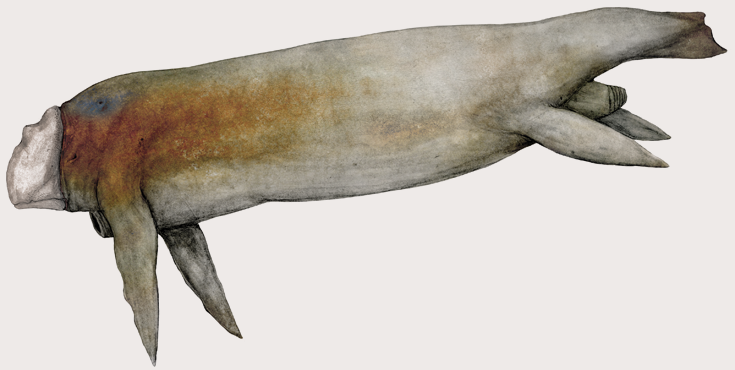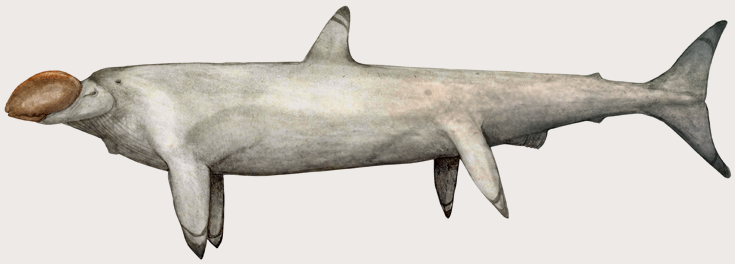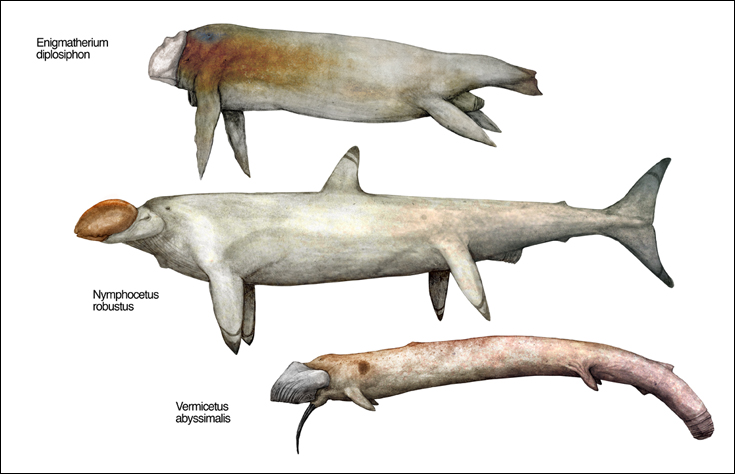Other "Jetocetes"
While the Jetocetid-Cardiocetid line of evolution might seem pretty straightforward, there are creatures on Snaiad which remind the observer that evolution always works through a series of branching radiations rather than a singular line of descent. These three groups, although clearly jet-propelled swimmers like the Jetocetes and the Cardiocetes, bear unique traits that make them impossible to be classified comfortably as members of either groups.

Species: Enigmatherium diplosiphon
Common Names: Chük, Great Babafingo, Dev Babafingo.
Size: 5-6 meters long.
Habitat: Shallow zones in the Sea of Plants.
The two or three species of Babafingos bear a maddening blend of characteristics that are found separately on Cardiocetes, Jetocetes and even the older ancestors of both of these groups. Like the Jetocetes, they have a clearly separated jet tract without heart-pumps. However, their breathing holes have migrated from their shoulders to their necks, just like in the Cardiocetes. But the greatest anomaly is to be found in their front and rear limbs. All Jetocetes or Cardiocetes have their limbs atrophied into fins, supported only by a series of peg-like bones. The Babafingos, however, have jointed paddle, which they use to crawl along the seafloor and even grasp and manipulate food items! Whether this characteristic is a long-retained ancestral feature or a freakish atavism is one of the most heated points of discussion in the world of Snaiadi zoology.
Babafingos live calm, uneventful lives that are blissfully unaware of these arguments. They spend time browsing in warm, shallow water; looking for the juicy underwater plants and certain bottom-living animals that constitute their diet. Although they are sluggish swimmers, they are able to defend themselves against predators by releasing great quantities of black, slimy, choking “ink” from a gland connected to their jet tracts.

Species: Nymphocetus robustus
Common Name: Nymph-whale.
Size: 4 meters long.
Habitat: Polar waters in the Great Northern, Aaritic and the Frigid Oceans.
This animal and several related species form a ring-species complex around the polar continent of Glacia. They are all fast, cruising predators on smaller marine animals. In this respect they look a lot like proper Jetocetes, but unlike them they have breathing holes on their necks and bizarre, accordion-like jet-guts that have no parallels in any other jet-powered swimmer. Stranger still, although this organ can and does give a large boost of speed in an emergency, Nymphocetus and relatives seldom use it operationally, instead relying on their muscular tails for propulsion. The reasons for this selective use are unknown, although keeping the icy seawater off the animals’ interior and maintaining the body temperature at tolerable levels clearly seems to play a role.

Species: Vermicetus abyssimalis
Common Name: None
Size: Up to 5 meters.
Habitat: Deep sea regions all around Snaiad.
Probing the depths of the abyss on Snaiad, the Vermicetids are a group of jet-swimmers that look strange on the inside as well as outside. While these creatures seem to be Cardiocetes at first sight, their heart-pumps are arranged a weird chain of twelve to sixteen “hearts”, while even the Polycardiac Cardiocetes have six “hearts” at most, and those are arranged in a radial, engine-like pattern. For a creature with so many jet pumps, Vermicetus is also strange in that it does not use any kind of jet action to swim. Instead, the hearts seem to function as buoyancy chambers, retaining or expelling water to maintain the animal at a preferred depth. If all of this wasn’t enough, Vermicetids also sport a pair of rear fins, which true Cardiocetes no longer bear. Unlike the rear fins of Jetocetes or other forms, however, the puzzling rear fins of Vermicetids are formed from outward puckerings of skin and dermal muscle, with no bones inside. Once again, the usual primitive-versus-derived-character debates surround all of these features.
Currently, only two species of Vermicetus are known. They all feed on abysmal swimmers they somehow find and kill in the murky darkness. Given the fantastically elusive nature of these creatures, it would appear that many other Vermicetid species are awaiting discovery in Snaiad’s depths.
Copyright laws protect all intellectual property associated with Snaiad.
All artwork, concepts and names associated with this project belong to C. M. Kosemen, unless otherwise stated.
